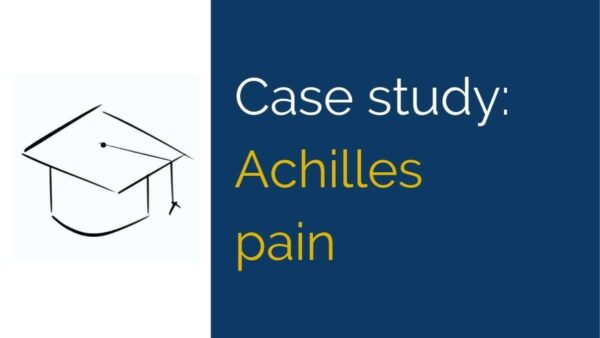Background – Achilles pain
This case study presents a recreational runner with unilateral Achilles pain. It covers the diagnosis of posterior ankle and heel pain, isolating potential causative factors and structuring an exercise-based approach to tendinopathies.
Minimum level
New Graduate Physiotherapist and Physiotherapy student
History
Ethan is a 38 year old accountant and recreational runner. He works 5 long days/week and aims to run 2 times per week for 8-10km.
Comment of Ethan’s situation and which factors put him at greater risk of tendinopathies.
He admits that running is often absent for 1-2 month periods when work gets busy. During these breaks from running, he doesn’t participate in any other form of exercise.
Explain the changes that occur in connective tissue with prolonged rest and initial return to loading.
Ethan began noticing a niggling Right Achilles pain around 4 months ago, becoming aware of it towards the end of a run. There were no symptoms after the run or in his Left Achilles.
What clarifying questions would you ask of Ethan after this information?
After resting from running for a few weeks, as a precaution and due to an illness, Ethan noticed that the pain seemed better on the first run. However after one week, the pain worsened and began to start earlier in the run.
In the last month, Ethan felt worsening Right Achilles pain throughout his entire run, remaining sore for the remainder of that day. He also notes pain due to pressure on the sensitive area from his work shoes.
He feels that a two month break from running (around 6 months ago) and some associated weight gain (up to 92kg from his usual 83kg) are to blame for this injury.
Discuss how these risk factors fit with your reasoning on underlying causes of Ethan’s injury.
Ethan has suffered similar Achilles pain over the years, usually lasting around a month and self-resolving. He can’t recall if it’s always the Right Achilles though. He denies having any ankle, knee or hip issues in the last 10 years.
Does the recurrent nature of Ethan’s issue affect your clinical reasoning on causes and management?
If it was a unilateral injury but affecting a different side with each episode, how does that impact your reasoning on causative factors?
Physical Examination
On observation, the Achilles appears to be a normal thickness.
Does this information fit with your provisional diagnosis?
Ethan’s stands with a moderate degree of overpronation on both feet.
Do you feel this is impacting Ethan’s biomechanics while running?
During a squat movement, Ethan struggles to maintain his balance below half depth, falling backwards on each rep. He reports a mild increase in his Right Achilles pain.
Provide your most likely reason behind the limited squat depth in Ethan’s case.
On heel raises, Ethan reports no pain or difficulty with the movement.
Explain, in the context of your provisional diagnosis, why a squat elicited some Achilles pain while heel raises did not.
On palpation, there is a very tender region at the base of the Right Achilles tendon, just at the Achilles tendon passes over the Calcaneus.
Name the structures that could cause this tenderness on palpation.
Ethan’s knee to wall test for ankle dorsiflexion was 6cm for both ankles.
Does this fit with your reasoning on causative biomechanics?
List three further tests that you would perform and explain what information you are looking to gain.
Diagnosis
Name and justify your provisional diagnosis for Ethan’s Achilles pain based on information from the case.
Explain your theory on the causative biomechanics that have lead to this injury.
Are their any interventions aside from exercise that you’d recommend to Ethan?
Management Plan
Design a management plan for Ethan, including exercises and a return to run program.
Provide recommendations specific to Ethan’s situation for prevention of future episodes.
Like to continue the conversation? Head over to our Facebook page.

